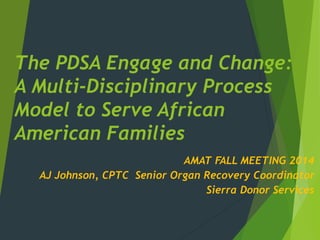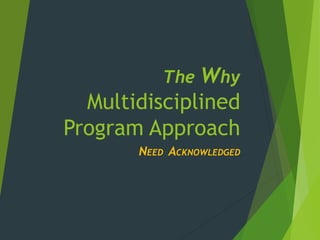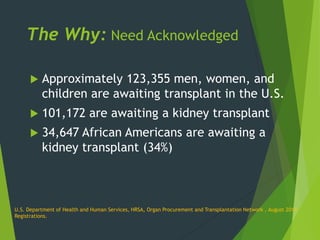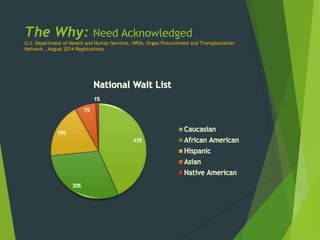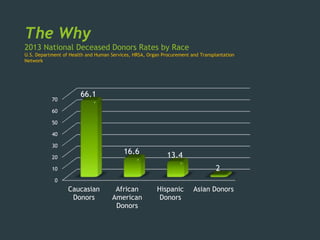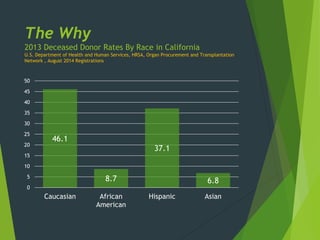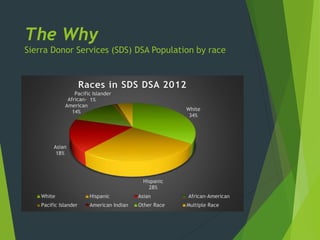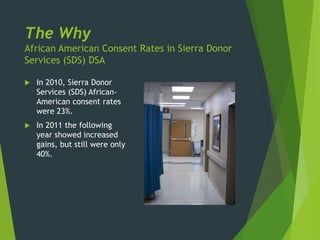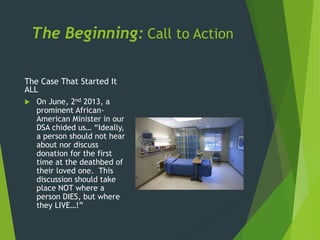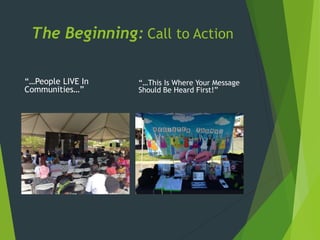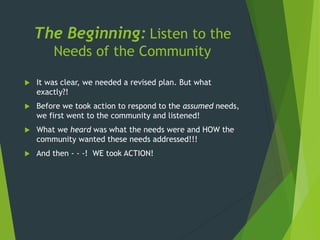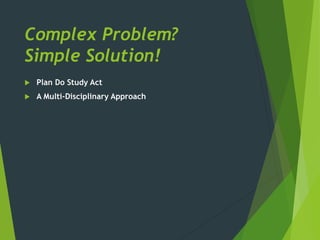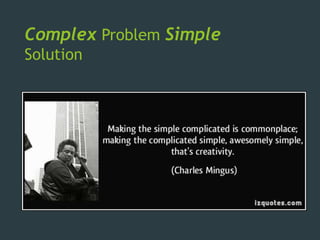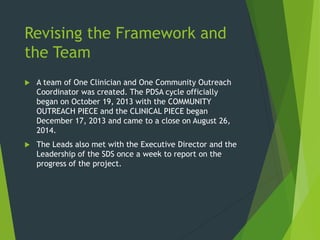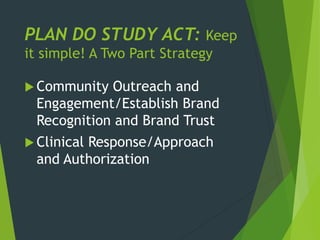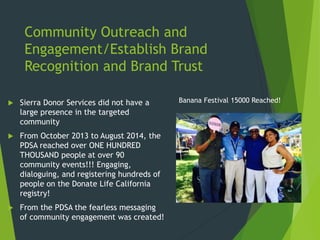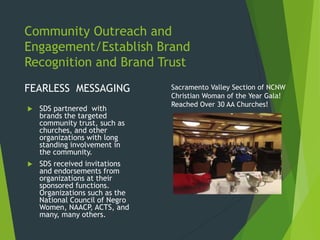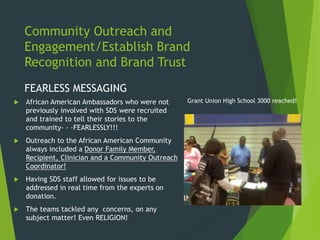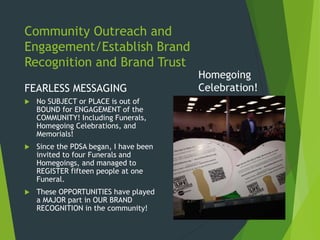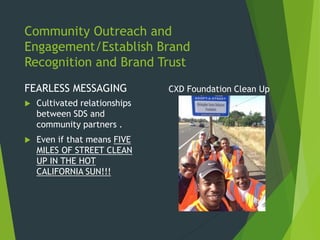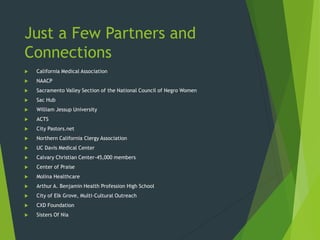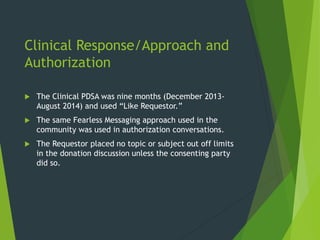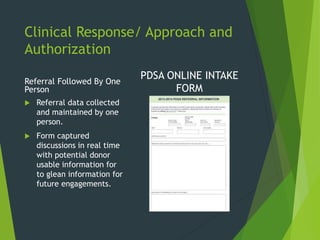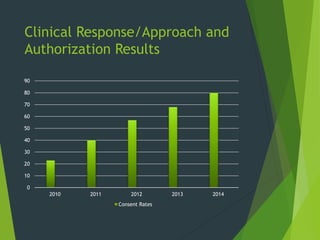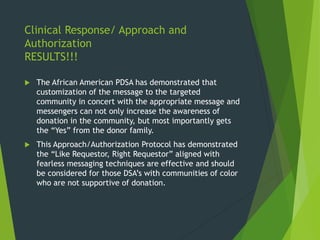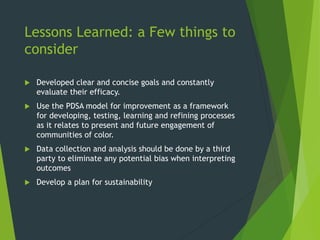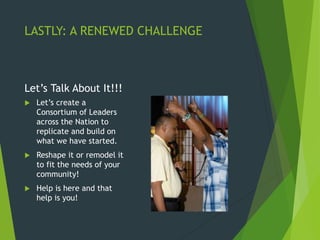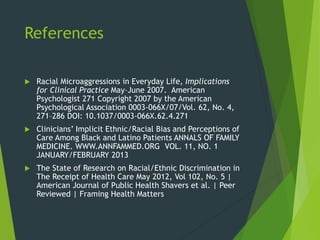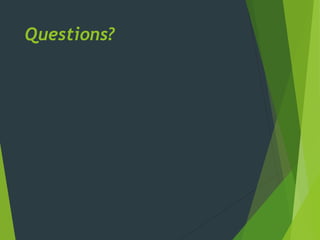AMATgreen
- 1. The PDSA Engage and Change: A Multi-Disciplinary Process Model to Serve African American Families AMAT FALL MEETING 2014 AJ Johnson, CPTC Senior Organ Recovery Coordinator Sierra Donor Services
- 2. The Why Multidisciplined Program Approach NEED ACKNOWLEDGED
- 3. The Why: Need Acknowledged ´üÁ ÔÇ£I know the benefits minority role models and mentors bring in helping a health- care workforce to flourish. From them I learned how to ease the burden of the inequities and disparities that my patients from racial/ethnic population groups suffer unjustifiably. Diversity and inclusion should be the foundations for our interactions with each other, our patients and our communities, as well as for our research and education programs.ÔÇØ David Acosta, M.D., FAAFP Associate Vice Chancellor, Diversity and Inclusion University of California Davis Health System Sr. Associate Dean for Equity, Diversity & Inclusion Health Sciences Clinical Professor UC Davis School of Medicine
- 4. The Why: Need Acknowledged ´üÁ Approximately 123,355 men, women, and children are awaiting transplant in the U.S. ´üÁ 101,172 are awaiting a kidney transplant ´üÁ 34,647 African Americans are awaiting a kidney transplant (34%) U.S. Department of Health and Human Services, HRSA, Organ Procurement and Transplantation Network , August 2014 Registrations.
- 5. The Why: Need Acknowledged U.S. Department of Health and Human Services, HRSA, Organ Procurement and Transplantation Network , August 2014 Registrations
- 6. The Why 2013 National Deceased Donors Rates by Race U.S. Department of Health and Human Services, HRSA, Organ Procurement and Transplantation Network 0 10 20 30 40 50 60 70 Caucasian Donors African American Donors Hispanic Donors Asian Donors 66.1 16.6 13.4 2
- 7. The Why 2013 Deceased Donor Rates By Race in California U.S. Department of Health and Human Services, HRSA, Organ Procurement and Transplantation Network , August 2014 Registrations 46.1 8.7 37.1 6.8 0 5 10 15 20 25 30 35 40 45 50 Caucasian African American Hispanic Asian
- 8. The Why Sierra Donor Services (SDS) DSA Population by race White 34% Hispanic 28% Asian 18% African- American 14% Pacific Islander 1% Races in SDS DSA 2012 White Hispanic Asian African-American Pacific Islander American Indian Other Race Multiple Race
- 9. The Why African American Consent Rates in Sierra Donor Services (SDS) DSA ´üÁ In 2010, Sierra Donor Services (SDS) African- American consent rates were 23%. ´üÁ In 2011 the following year showed increased gains, but still were only 40%.
- 10. The Beginning: Call to Action The Case That Started It ALL ´üÁ On June, 2nd 2013, a prominent African- American Minister in our DSA chided usÔǪ ÔÇ£Ideally, a person should not hear about nor discuss donation for the first time at the deathbed of their loved one. This discussion should take place NOT where a person DIES, but where they LIVEÔǪ!ÔÇØ
- 11. The Beginning: Call to Action People LIVE In Communities This Is Where Your Message Should Be Heard First!
- 12. The Beginning: Listen to the Needs of the Community ´üÁ It was clear, we needed a revised plan. But what exactly?! ´üÁ Before we took action to respond to the assumed needs, we first went to the community and listened! ´üÁ What we heard was what the needs were and HOW the community wanted these needs addressed!!! ´üÁ And then - - -! WE took ACTION!
- 13. Complex Problem? Simple Solution! ´üÁ Plan Do Study Act ´üÁ A Multi-Disciplinary Approach
- 15. Revising the Framework and the Team ´üÁ A team of One Clinician and One Community Outreach Coordinator was created. The PDSA cycle officially began on October 19, 2013 with the COMMUNITY OUTREACH PIECE and the CLINICAL PIECE began December 17, 2013 and came to a close on August 26, 2014. ´üÁ The Leads also met with the Executive Director and the Leadership of the SDS once a week to report on the progress of the project.
- 16. PLAN DO STUDY ACT: Keep it simple! A Two Part Strategy ´üÁ Community Outreach and Engagement/Establish Brand Recognition and Brand Trust ´üÁ Clinical Response/Approach and Authorization
- 17. Community Outreach and Engagement/Establish Brand Recognition and Brand Trust Banana Festival 15000 Reached!´üÁ Sierra Donor Services did not have a large presence in the targeted community ´üÁ From October 2013 to August 2014, the PDSA reached over ONE HUNDRED THOUSAND people at over 90 community events!!! Engaging, dialoguing, and registering hundreds of people on the Donate Life California registry! ´üÁ From the PDSA the fearless messaging of community engagement was created!
- 18. Community Outreach and Engagement/Establish Brand Recognition and Brand Trust FEARLESS MESSAGING ´üÁ SDS partnered with brands the targeted community trust, such as churches, and other organizations with long standing involvement in the community. ´üÁ SDS received invitations and endorsements from organizations at their sponsored functions. Organizations such as the National Council of Negro Women, NAACP, ACTS, and many, many others. Sacramento Valley Section of NCNW Christian Woman of the Year Gala! Reached Over 30 AA Churches!
- 19. Community Outreach and Engagement/Establish Brand Recognition and Brand Trust FEARLESS MESSAGING ´üÁ African American Ambassadors who were not previously involved with SDS were recruited and trained to tell their stories to the community- - -FEARLESSLY!!! ´üÁ Outreach to the African American Community always included a Donor Family Member, Recipient, Clinician and a Community Outreach Coordinator! ´üÁ Having SDS staff allowed for issues to be addressed in real time from the experts on donation. ´üÁ The teams tackled any concerns, on any subject matter! Even RELIGION! Grant Union High School 3000 reached!
- 20. Community Outreach and Engagement/Establish Brand Recognition and Brand Trust FEARLESS MESSAGING ´üÁ No SUBJECT or PLACE is out of BOUND for ENGAGEMENT of the COMMUNITY! Including Funerals, Homegoing Celebrations, and Memorials! ´üÁ Since the PDSA began, I have been invited to four Funerals and Homegoings, and managed to REGISTER fifteen people at one Funeral. ´üÁ These OPPORTUNITIES have played a MAJOR part in OUR BRAND RECOGNITION in the community! Homegoing Celebration!
- 21. Community Outreach and Engagement/Establish Brand Recognition and Brand Trust FEARLESS MESSAGING ´üÁ Cultivated relationships between SDS and community partners . ´üÁ Even if that means FIVE MILES OF STREET CLEAN UP IN THE HOT CALIFORNIA SUN!!! CXD Foundation Clean Up
- 22. Just a Few Partners and Connections ´üÁ California Medical Association ´üÁ NAACP ´üÁ Sacramento Valley Section of the National Council of Negro Women ´üÁ Sac Hub ´üÁ William Jessup University ´üÁ ACTS ´üÁ City Pastors.net ´üÁ Northern California Clergy Association ´üÁ UC Davis Medical Center ´üÁ Calvary Christian Center-45,000 members ´üÁ Center of Praise ´üÁ Molina Healthcare ´üÁ Arthur A. Benjamin Health Profession High School ´üÁ City of Elk Grove, Multi-Cultural Outreach ´üÁ CXD Foundation ´üÁ Sisters Of Nia
- 23. Clinical Response/Approach and Authorization ´üÁ The Clinical PDSA was nine months (December 2013- August 2014) and used ÔÇ£Like Requestor.ÔÇØ ´üÁ The same Fearless Messaging approach used in the community was used in authorization conversations. ´üÁ The Requestor placed no topic or subject out off limits in the donation discussion unless the consenting party did so.
- 24. Clinical Response/ Approach and Authorization Referral Followed By One Person ´üÁ Referral data collected and maintained by one person. ´üÁ Form captured discussions in real time with potential donor usable information for to glean information for future engagements. PDSA ONLINE INTAKE FORM
- 25. Clinical Response/Approach and Authorization Results 0 10 20 30 40 50 60 70 80 90 2010 2011 2012 2013 2014 Consent Rates
- 26. Clinical Response/ Approach and Authorization RESULTS!!! ´üÁ The African American PDSA has demonstrated that customization of the message to the targeted community in concert with the appropriate message and messengers can not only increase the awareness of donation in the community, but most importantly gets the ÔÇ£YesÔÇØ from the donor family. ´üÁ This Approach/Authorization Protocol has demonstrated the ÔÇ£Like Requestor, Right RequestorÔÇØ aligned with fearless messaging techniques are effective and should be considered for those DSAÔÇÖs with communities of color who are not supportive of donation.
- 27. Lessons Learned: a Few things to consider ´üÁ Developed clear and concise goals and constantly evaluate their efficacy. ´üÁ Use the PDSA model for improvement as a framework for developing, testing, learning and refining processes as it relates to present and future engagement of communities of color. ´üÁ Data collection and analysis should be done by a third party to eliminate any potential bias when interpreting outcomes ´üÁ Develop a plan for sustainability
- 28. LASTLY: A RENEWED CHALLENGE LetÔÇÖs Talk About It!!! ´üÁ LetÔÇÖs create a Consortium of Leaders across the Nation to replicate and build on what we have started. ´üÁ Reshape it or remodel it to fit the needs of your community! ´üÁ Help is here and that help is you!
- 29. References ´üÁ Racial Microaggressions in Everyday Life, Implications for Clinical Practice MayÔÇôJune 2007. American Psychologist 271 Copyright 2007 by the American Psychological Association 0003-066X/07/Vol. 62, No. 4, 271ÔÇô286 DOI: 10.1037/0003-066X.62.4.271 ´üÁ CliniciansÔÇÖ Implicit Ethnic/Racial Bias and Perceptions of Care Among Black and Latino Patients ANNALS OF FAMILY MEDICINE. WWW.ANNFAMMED.ORG VOL. 11, NO. 1 JANUARY/FEBRUARY 2013 ´üÁ The State of Research on Racial/Ethnic Discrimination in The Receipt of Health Care May 2012, Vol 102, No. 5 | American Journal of Public Health Shavers et al. | Peer Reviewed | Framing Health Matters
- 30. Questions?
Editor's Notes
- #2: Good Morning! My name is AJ Johnson, Senior Organ Recovery Coordinator from Sierra Donor Services located in Sacramento California. I am both honored and humbled to address you all today.
- #3: I spent 13 years in the United States Army, and IÔÇÖd like to share with you all something that was taught to me while I was there. The B.L.U.F.F.!!!! (BOTTOM LINE UP FRONT FIRST!) This is a way of speaking that we use in the Army! ItÔÇÖs a type of speak, that gets to the ROOT of the matter quickly without any added fillers or fluff. ItÔÇÖs efficient. ItÔÇÖs HONEST. And most of all, itÔÇÖs effective. The BLUFF here AS it pertains to this PRESENTATION and more importantly the NEED, is simple! YES! As you all can see on the screen, ÔÇ£The need of ALL has been ACKNOWLEDGE!ÔÇØ But this STATEMENT is incomplete! YES! THERE IS A PROBLEM THAT WE HAVE ALL ACKNOWLEDGED! THIS is EVIDENT by your presence here at AMAT this week! The BOTTOM LINE UP FRONT FIRST as it pertains to what faces us, is a SIMPLE SOLUTION that has been made far too COMPLEX! By institutional and organization apathy, and unwillingness to fully engage this problem head on, we ALL are culpable. Sure! We have studied, probed, poked, and postulated for years! But what have we DONE? Time is wasted and with this stagnancy comes with it the unnecessary loss of lives. Lives WE are committed to saving.
- #4: Dr. David Acosta is not only the Vice Chancellor of Diversity and Inclusion for UC Davis Health System, but IÔÇÖm honored to call him a friend, a teacher, and further our Principal Investigator in a pending grant proposal our OPO and UC Medical Center are co-authoring. This statement serves not only as the framework of the intent of this effort, but highlights the CHALLENGES we faced and continue to WORK to overcome. In HOSPITALS in our small DSA in Sacramento, California I have personally witnessed the inequities in CARE and treatment of racial/ethnic population groups first hand. In one case, a physician caring for an African American family expressed his explicit bias openly regarding African Americans. ÔÇ£Stating why should I stay late to help you with this patient? Black People donÔÇÖt donate any wayÔÇØ And this hostile rhetoric is just the tip of the iceberg. Over the last three years WE began to notice a pattern in the way African American families were served by the hospitals in our region. This first hand observation coupled with the testimonials from community members about the way they are treated prior to the ASK from the OPO, and further how the OPO was perceived by the community, made us realize that we needed to address not only the ethnic discrimination occurring in health care in our DSA, but the OPO Brand in our community. Creating this PDSA would be an avenue for a FEW of us to bring change and hopes of equitable care and treatment to the MANY.
- #5: Beans and Bullets-the weapons, munitions, equipment, and supplies of a military needed to accomplish a mission. We all know this information, right? SO I wonÔÇÖt bore you with the details. THE FOLLOWING SLIDES ARE HERE ONLY TO HIGHLIGHT THE DISPARITY. Thousands of people are awaiting kidney transplantation in this country: A large proportion of those are AA awaiting kidney transplantation .
- #6: Racial/ Ethnic groups make up almost 60% of national waiting list.
- #7: The U.S statistics on deceased donor rates point to a drastic shortage of AA Donors.
- #8: I know you all have seen and are quite familiar with these national numbers. I believe showing them to you can give you perspective on what we are up against in California. The U.S statistics on deceased donor rates point to a drastic shortage of AA Donors. NOTE CONTRAST OF DECEASED DONOR RATES NATIONALLY VERSES CALIFORNIA. WAIT TIMES ARE ON AVERAGE 10 YEARS!!! In California, total population of 33,871,648. 34% are registered donors. California Active OPOs 4 Active TXCs22 OPO╠²: Organ Procurement Org.╠² TXC╠²: Transplant Center
- #9: African Americans only account for appx 6.9% of the California Population. However, African Americans more than double that in SDS DSA and is more in line with the National Population rates.
- #12: And from the CHALLENGE grew a relationship! Dr. Brown would invite SDS to join him and his church in the ChurchÔÇÖs first annual Community engagement event called the Capitol City Block Party!
- #13: It was clear we NEEDED a plan! For the ÔÇ£in box thinkingÔÇØ one size fits all approach we had was a complete and utter failure as it pertained to communities of color.
- #15: CHARLES MINGUS-One of the most important figures in twentieth century American music, Charles Mingus was a virtuoso bass player, accomplished pianist,╠²bandleader and composer. Born on a military base in Nogales, Arizona in 1922 and raised in Watts, California, his earliest musical influences came from the churchÔÇô choir and group singingÔÇô and from ÔÇ£hearing Duke Ellington over the radio when [he] was eight years old.ÔÇØ He studied double bass and composition in a formal way (five years with H. Rheinshagen, principal bassist of the New York Philharmonic, and compositional techniques with the legendary Lloyd Reese) while absorbing vernacular music from the great jazz masters, first-hand. His early professional experience, in the 40ÔÇ▓s, found him touring with bands like Louis Armstrong, Kid Ory and Lionel Hampton. In my OPINION if there were a ÔÇ£Mount RushmoreÔÇØ of Jazz musicians, Charles Mingus would occupy the first three HEADS!
- #17: We chose to use the PDSA CHANGE MODEL given it allows for fluidity, and expansiveness in a real time and real world environment. Our strategy was a multidiscipline two prong approach. IHI uses the Model for Improvement as the framework to guide improvement work. The Model for Improvement, developed by Associates in Process Improvement, is a simple, yet powerful tool for accelerating improvement. This model is not meant to replace change models that organizations may already be using, but rather to accelerate improvement.
- #18: To say Sierra Donor Services (SDS) otherwise known as the DONOR BRAND was didnÔÇÖt have a large presence in the AA community is an understatement. The truth was SDS was either alien or unknown at best, and vehemently despised at worst by the targeted community. So we had to go about fixing our BRAND! Strengthening the BRAND and creating a new BRAND EXPERIENCE! What is a BRAND? A collection of images and ideas representing a producers; it refers to the descriptive verbal attributes and concrete symbols such as name, logo, slogan, and or design that conveys the essence of a company. It is a symbolic embodiment of al information connected to a company, product, or service. Marketers╠²distinguish╠²the╠²psychological╠²aspect╠²of╠²a╠²brand from the experimental aspect.╠²The╠²experiential╠²aspect╠²consists╠²of the sum of all points of contact with the╠²brand╠²and╠²is╠²known╠²as the BRAND EXPERIENCE!╠²The psychological aspect sometimes referred to as the BRAND IMAGE,╠²is a symbolic construct created within the minds of people and consists of the information and expectations associated with a product or service. Marketers╠²engaged╠²in╠²branding╠²seek╠²to╠²develop╠²or╠²align╠²the expectations behind╠²the╠²BRAND╠²EXPERIENCE,╠²creating╠²the╠²impressions╠²that╠²a╠²brand associated╠²with╠²a product or service has certain qualities or characteristics that make it unique or special. ╠²A╠²BRAND╠²is╠²therefore╠²one╠²of╠²the╠²most VALUABLE ╠²elements╠²in╠²an ADVERTISING╠²theme,╠²as╠²it╠²demonstrates what╠²the╠²brand╠²owner╠²is╠²able╠²to╠²offer╠²in╠²the CONSUMER! BRAND RECOGNITION when a widely known and trusted in the marketplace, when BRAND RECOGNITION builds up to a point where a brand enjoys critical mass of POSITIVE SENTIMENT in the marketplace, it is achieves BRAND FRANCHISE!
- #19: Partnered the DONOR BRAND with BRANDS the targeted community trust, such as Churches, and other organizations with long standing historical tactile involvement in the community with proven service resulting in community trust. Received invitations and endorsements from organizations at their sponsored functions. Organizations such as the National Council of Negro Women, NAACP, ACTS, and many, many others. These events led to AA Churches actually REACHING OUT TO US!!! Stating that ÔÇ£SDS is Big Time!ÔÇØ
- #20: We hand picked our team of ambassadors who had shown the propensity for this type of ÔÇ£guerilla styleÔÇØ engagement. Most received training that was not ÔÇ£one size fits allÔÇØ that was offered by our organization. We tailored there training in respects to their individual needs, strengths, and weaknesses.
- #24: LIKE REQUESTOR, RIGHT REQUESTOR BLUFF? One clinician on call everyday for all African American referrals and approaches. BEANS and BULLETS? Philosophical differences in approach can make a huge difference. In our OPO we identified problems with consent/conversion approaches! Consent not tracked. No ongoing organized training for those who consent. This was seen as an assumed ÔÇ£skillÔÇØ that new ORCÔÇÖs would have just on the virtue of working as a bedside RN, or a paramedic. As you all know, this is NOT true! The SKILLS needed for APPROACH should never be ASSUMED, they should be TAUGHT! And the organization should have a continued INVESTMENT in the CONTINUAL TRAINING OF Without the ÔÇ£YESÔÇØ lives are not saved. BOTTOM LINE UP FRONT FIRST! WhatÔÇÖs the BLUFF?!
- #25: Our data collection was not limited to just that of demographic and clinical details, we also collected testimonials from family members, deviations of standards of care practices, observations of staff cultural competency as it relates to this population.
- #28: Always keeping the NEEDS of THOSE WE SERVE and their families at the forefront of what we do. Engaging organizational and senior leadership support to help reduce barriers and obstacles that may occur. Focusing on strategies to facilitate the spread and sustainability of this EFFORT.
- #29: IÔÇÖd like to SHARE the same challenge given to me to you!
- #31: In order that we SAVE lives tomorrow and in the days to come, we must leave here today committed to the level of courage and selflessness that our DONOR family exemplifies. When given the hard choice, THESE FAMILIES chose to GIVE, they chose to SERVE! They chose a path that certainly at the very least IS uncomfortable. But look at what that BRINGS--- LIFE! We MUST put aside ourselves, for the better of all, for ALL are whom we serve. IMAGINE If every person in this room, including myself and OPO staff, ICU nurses and physicians, Hospital Administrators and ancillary staff commit to this example of selflessness and service now, over the next year many lives will be impacted? Bodies will be healed; families will be comforted, because lives will be saved. SO I ask you, what choice will you make when you leave here today? Will you let the ordinary and the familiar routines as you return to your respective places of employment lead you away from what WE shared here today? As the echoes of the words spoken become mere whispers, and the emotions WE have shared become faded recollections of a whimsical day, will the routines of your comforts paralyze you to inaction and apathy? Or will you take what WE have been given here today and let this newfound SPIRIT of COOPERATION and TEAMWORK guide US to selflessly serve ALL who we are in NEED? The CHOICE is yours---Unite as ONE team across this GREAT NATION with ONE mission and the COMPLEX will become SIMPLE and the impossible becomes POSSIBLE. This is my BLUFF!!!

